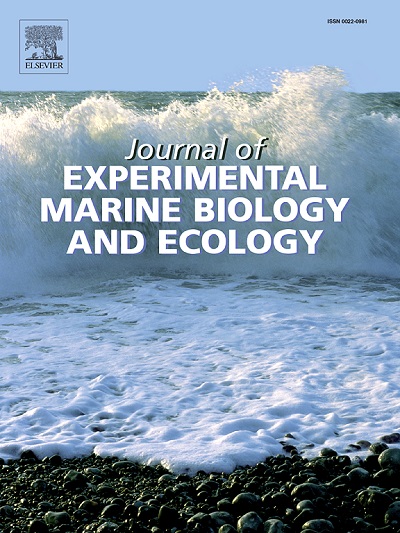The ecological effects of hard-bottom habitat degradation on the Florida stone crab
IF 1.8
3区 生物学
Q3 ECOLOGY
Journal of Experimental Marine Biology and Ecology
Pub Date : 2025-01-01
DOI:10.1016/j.jembe.2024.152075
引用次数: 0
Abstract
Repeated cyanobacterial blooms in Florida Bay have resulted in the degradation of hard-bottom habitat throughout the region. Despite the loss of structure-forming sponges, nothing is known about the effects on the iconic Florida stone crab, Menippe mercenaria, which utilize hard-bottom to shelter and forage. We examined the potential impacts of these algal blooms by comparing crab nutritional condition, trophic position, and site fidelity between bloom-impacted and non-impacted regions. Menippe mercenaria from both regions were of similar nutritional condition; however, δ15N stable isotope analysis revealed M. mercenaria to have greater trophic variability in bloom-impacted regions, suggesting crabs in degraded habitats foraged on a wider variety of prey. δ13C measurements showed a marked shift between regions, suggesting the source of primary production in these regions differed in δ13C values, species composition, or both. Site and den fidelity remained similar; likely due to the abundance of solution holes available as shelters. Overall, results indicate M. mercenaria have high resiliency to the habitat degradation caused by these blooms, but fundamental changes in their trophic ecology suggest that blooms could be causing a broader alteration to these communities.
硬底生境退化对佛罗里达石蟹的生态影响
佛罗里达湾反复出现的蓝藻繁殖导致了整个地区硬底栖息地的退化。尽管失去了形成结构的海绵,但对标志性的佛罗里达石蟹(Menippe mercenaria)的影响一无所知,它们利用硬底来遮蔽和觅食。我们通过比较受藻华影响和未受藻华影响地区的蟹的营养状况、营养地位和地点保真度来研究这些藻华的潜在影响。两地区佣兵的营养状况相似;然而,δ15N稳定同位素分析显示,M. mercenaria在开花影响区域具有更大的营养变异性,这表明退化栖息地的螃蟹觅食的猎物种类更广泛。δ13C测量值在不同区域之间有明显的变化,表明这些区域的初级生产来源在δ13C值、物种组成或两者之间存在差异。地点和巢穴的保真度保持相似;可能是因为有大量的溶洞可以作为避难所。总体而言,研究结果表明,柽柳对这些水华引起的生境退化具有较高的恢复能力,但其营养生态的根本变化表明,水华可能会对这些群落造成更广泛的改变。
本文章由计算机程序翻译,如有差异,请以英文原文为准。
求助全文
约1分钟内获得全文
求助全文
来源期刊
CiteScore
4.30
自引率
0.00%
发文量
98
审稿时长
14 weeks
期刊介绍:
The Journal of Experimental Marine Biology and Ecology provides a forum for experimental ecological research on marine organisms in relation to their environment. Topic areas include studies that focus on biochemistry, physiology, behavior, genetics, and ecological theory. The main emphasis of the Journal lies in hypothesis driven experimental work, both from the laboratory and the field. Natural experiments or descriptive studies that elucidate fundamental ecological processes are welcome. Submissions should have a broad ecological framework beyond the specific study organism or geographic region.
Short communications that highlight emerging issues and exciting discoveries within five printed pages will receive a rapid turnaround. Papers describing important new analytical, computational, experimental and theoretical techniques and methods are encouraged and will be highlighted as Methodological Advances. We welcome proposals for Review Papers synthesizing a specific field within marine ecology. Finally, the journal aims to publish Special Issues at regular intervals synthesizing a particular field of marine science. All printed papers undergo a peer review process before being accepted and will receive a first decision within three months.

 求助内容:
求助内容: 应助结果提醒方式:
应助结果提醒方式:


